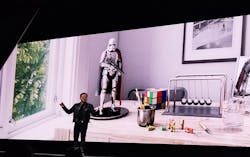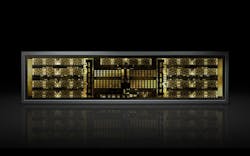Music from The Greatest Showman started out NVIDIA’s Jensen Huang’s keynote at this year’s Graphics Technology Conference (GTC). He took centerstage for over two hours, keeping the audience on the edge most of the time talking about NVIDIA’s latest technologies from its new ray-tracing support (Fig. 1) to the DGX-2.
1. One of the main highlights of Jensen Huang’s keynote was NVIDIA’s new ray-tracing support, which delivers phenomenal images in real time.
The DGX-2 takes advantage of the new 32-GB Tesla V100 that doubles the amount of on-chip, high bandwidth memory (HBM2) and incorporates NVIDIA’s 18-port NVLink NVSwitches (Fig. 2). The Tesla V100 has half-a-dozen NVLink connections that can be used to build a system with eight GPGPUs without needing a switch. This is the configuration employed with the earlier DGX-1.
2. The NVSwitch provides a 18-port crossbar connection using high-speed NVLink connections.
The DGX-2 has 16 GPGPUs connected through a dozen NVSwitch chips (Fig. 3). The fully interconnected systems sports 512 GB of HBM2 memory space accessible to all GPGPUs, creating essentially one giant GPGPU with 10,240 CUDA cores. In theory, the NVSwitch approach could be used to create even larger systems.
3. The exploded view of the DGX-2 highlights the two trays, each with eight Tesla V100 GPGPUs and six NVSwitch chips. The system has a single memory space with 512 GB of HBM2 memory.
The system also has a pair of Intel Skylake-SP Xeon Platinum CPUs with 1.5 TB of DRAM, and up to 60 TB of NVMe solid-state storage. The DGX-2 costs $399K and uses 10 kW of power. Connectivity includes eight InfiniBand EDR or 100-Gb Ethernet ports. It can deliver 2 petaFLOPS (PFLOPS) of performance.
This alone would be a great act, but the hits just kept on coming.
The ray-tracing announcement was only the first part of the presentation. Ray tracing tends to be the holy grail for graphics gurus. It’s the approach used by Hollywood to create photorealistic movies; however, a single frame took minutes to hours depending on resolution and complexity. Real-time 3D gaming uses all sorts of shortcuts and tricks to approach that effect, but the differences are noticeable and fall short of a ray-traced image that’s essentially indistinguishable from a high-resolution photograph.
NVIDIA’s real-time ray-tracing support, called NVIDIA RTX, is available on the Quadro GV100 (Fig. 4). It has four GPUs tied together using NVLink connections. It’s essentially half a DGX-1 on a board. The new board delivers up to 7.4 TFLOPS of double-precision. Add another board using NVLink connections and it doubles the HMB2 support to 64 GB.
4. The NVIDIA Quadro GV100 uses a pair of NVLinked V100 GPUs to deliver real-time ray-tracing support.
There was a lot more in the keynote, including coverage of NVIDIA’s automotive simulation and self-driving car support. I know I found the excitement through the entire session to be amazing, given some of the more sedate or less-relevant keynotes at other shows.
I did want to mention one very minor item that perhaps no one else noticed, but Jensen did tell “the guys” they did a great job. The reason I bring this up is that the presentation given to the press before the keynote highlighted diversity, and how the number of women at the conference who were presenting, although low overall, was increasing. A nod to the “guys and gals” would be appropriate next year. It’s just a reminder that our good intentions often get mixed up with our traditional ways of communicating. I do it all the time and try to remind myself about it. It was also one of the themes in The Greatest Showman.
In closing, great job Jensen, and to your diverse team at NVIDIA.
About the Author
William G. Wong
Senior Content Director - Electronic Design and Microwaves & RF
I am Editor of Electronic Design focusing on embedded, software, and systems. As Senior Content Director, I also manage Microwaves & RF and I work with a great team of editors to provide engineers, programmers, developers and technical managers with interesting and useful articles and videos on a regular basis. Check out our free newsletters to see the latest content.
You can send press releases for new products for possible coverage on the website. I am also interested in receiving contributed articles for publishing on our website. Use our template and send to me along with a signed release form.
Check out my blog, AltEmbedded on Electronic Design, as well as his latest articles on this site that are listed below.
You can visit my social media via these links:
- AltEmbedded on Electronic Design
- Bill Wong on Facebook
- @AltEmbedded on Twitter
- Bill Wong on LinkedIn
I earned a Bachelor of Electrical Engineering at the Georgia Institute of Technology and a Masters in Computer Science from Rutgers University. I still do a bit of programming using everything from C and C++ to Rust and Ada/SPARK. I do a bit of PHP programming for Drupal websites. I have posted a few Drupal modules.
I still get a hand on software and electronic hardware. Some of this can be found on our Kit Close-Up video series. You can also see me on many of our TechXchange Talk videos. I am interested in a range of projects from robotics to artificial intelligence.






